

Automotive News and Reviews for the Petrolhead
Reuters Motoring Commentator
In this week's issue:
- Impreza Gets Extra STi-mulation
- The Price of Credibility, Quality and Kudos
Subaru has a spectacular track record in getting the marketing for its Impreza all wrong.
Then Subaru relented with the new generation Impreza and finally gave us a European version of the STi in 2002. But with its cringeworthy bug-eye headlamp design, it made few friends. The chorus of criticism was so strong that, after just one year on sale, Subaru has done the right thing and redesigned the Impreza's front end. As part of its revamp, it has taken the opportunity to give the already mighty STi even sharper manners.
This is a monster of a car but the questions remains, is it better than its arch rival, Mitsubishi's Evo VIII? There's only one way to find out?
Stop Taking the Ugly Pills
At first sight, the new Impreza is as engaging as the old one was gawky. The low-rent circular headlamps of the old model are replaced by rather more aggressively styled lights that Subaru calls "three dimensional" - whatever that means.
They are complimented by a new front bumper, a larger bonnet intake that looks like a squashed post-box and rear spoiler that's starting to resemble a full-scale pylon. (Just in case you're wondering, yes, it is right in the line of sight of your rear view.) You still can't call the Impreza pretty but its testosterone-charged body kit swivels petrol heads wherever you go.
The new bodywork is more aerodynamic so top speed goes up fractionally to 151mph. But top speed is not what the STi is about. Its gearing is maniacally low, so at 70mph there's a turbo-whine tinged screech that has you clawing at your ears. That torture is all worthwhile, however, because when you're punching up through the close-ratio six-speed gearbox, every upchange brings the rev counter slap bang back into the middle of a colossal power band. It could do with a slicker gearchange, however.
Sharp Bends
Grip around bends was always the Impreza's most impressive attribute. Now the suspension - surprisingly soft in the last generation STi - is tougher, and it shows. The ride is crashier but the flipside is even sharper cornering, also helped by a faster steering rack (just 2.6 turns of the wheel lock-to-lock). While the chassis basically understeers as it reaches its (scarcely believable) limits, it feels more adjustable than before. You can induce oversteer or stick with safe, four-wheel drive neutrality.
The flat-four turbocharged engine has been left largely untouched. The only real change is a larger intercooler. Speaking of which, you have the fabulously surreal ability to hit a switch on the dashboard that operates a water-spray for the intercooler. Apparently this spurt can provide the engine with a small, brief surge in power. Just imagine yourself exiting a tight bend and deciding you need to turn the volume knob to eleven - now where's that button??
Tacky Plastics
Surprisingly, the Impreza is relatively easy to live with: more docile in traffic than you'd expect and with plenty of space for five adults. On the other hand, road and wind noise have you reaching for your earplugs, it absolutely chomps fuel and insurance group 20 won't do anything for your bank balance.
And so to the crucial question: is the Impreza STi better than Mitsubishi's new Evo VIII? That's a tough one. While the STi finally goes and looks the way it should always have done, the 280bhp Evo is undeniably quicker (it will do 0-60 in 4.8 seconds) and it has a far stronger torque curve. The Mitsubishi is also sharper around bends thanks to its array of electronic cornering aids. On the downside, it's dull to look at, the engine lacks the STi's charismatic burble and it costs two grand more. And Mitsubishi doesn't have a world rally team this year. Potential Tommi Makinens should therefore sign up, like he did, to Subaru.
The Aston Martin Vanquish takes your breath away with its jaw-dropping looks and towering performance.
Something Familiar for the Weekend Sir?
But what leaves me literally choking is the fact that the Vanquish also has the same electric window switches as an old Ford Mondeo. The air vents are rather familiar too, along with a few other ancillary controls, and in my view, this is simply not on.
The Vanquish brochure quite clearly states that 'each car will be hand-built, in true Aston Martin tradition, to the exact and individual requirements of its owner'. Which is a bit confusing really, because I can't imagine a single Vanquish customer specifically asking his Aston dealer to fit a few left-over bits from an old Ford before handing over a cheque, can you?
Which is somewhere between ridiculous and scandalous for £158,000 isn't it? Ford is the world's second largest car company. It ought to be machining switches from a light-alloy and Bakelite composite for that money, on a car like this, but today the economies of scale are all-important. Cutting costs in pursuit of greater profit is the name of the game, thereby ensuring that the public gets what the Public (Limited Company) wants. But I suspect you already know this.
Now when it comes to scale, Ford is vast. Aside from building millions of its own products every year, it is also responsible for Lincoln, Mercury, Jaguar, Land Rover and, of course, Aston. In 1999, Ford bought Volvo too. And since 1979, it has been increasing its original 25% stake in Mazda.
All in the Family
But this isn't pick-on-Ford week and the American giant is not alone (clearly it's got all those different brands to keep it company). General Motors, another major US conglomerate, is the world's number one motor manufacturing company and owns 12 major car companies (soon to become 11, when Oldsmobile finally goes the way of the Dodo). Alongside famous US names like Cadillac, Chevrolet and Pontiac, GM owns the British volume brand, Vauxhall, as well as its German and Australian equivalents Opel and Holden. In 2000, GM increased its 50% stake in Saab to 100% and one year later paid $400 million for Daewoo (now GM Daewoo), the second biggest car company in Korea, behind Hyundai (which owns around 35% of Kia, by the way, and is itself 10% owned by Mercedes-Benz). Are you keeping up?
Which is much like all the leading Japanese makers. Toyota, the world's fourth major automotive corporation, does own another brand (Lexus) but it started this company itself to build (much) posher Toyotas. Similarly, Honda has a different business focus (its diversification includes being the world's number one motorcycle manufacturer and a variety of other marine and power manufacturing businesses) while at Nissan, Japan's number two, the boot is on the other foot. Nissan is part owned by the French!
As part of a new model development agreement, Renault holds a 44% stake in Nissan although, in return, Nissan also has a 15% stake in Renault (what?), a former nationalised industry that is still 26% owned by the French Government! The other two major French manufacturers, Peugeot and Citroen (collectively known as PSA), merged some thirty years ago and these days it can be very tricky to distinguish one from the other - take the badges off the new 807 (Peugeot) or C8 (Citroen) people carriers and you simply canıt. Why not save a few Francs more and put the same badge on both cars?
And we're not done yet. Saving money is exactly what Fiat, Italy's motoring monopoly, is trying to do right now. This financially-troubled, family-controlled business owns Maserati, Lancia and Alfa Romeo, as well as a controlling interest in Ferrari, and has a very long history of international collaboration, including alliances with General Motors and, during the 1970s, a stake in the Spanish firm SEAT.
Which (stay with it) is now owned by Volkswagen, along with Audi, Bentley, Bugatti, Lamborghini and Skoda, making VW Group the fifth largest motor manufacturing company in the world. And it is as guilty of badge-engineering its 'corporate' product as anyone is. A SEAT Leon is based on the VW Golf. The SEAT Alhambra is also a VW Sharan (as well as a Ford Galaxy, but that's a different story), and the Skoda Superb is actually (better than) a stretched Volkswagen Passat.
But so what, you might be asking. Do people really care if the new Saab 9-3 is based on a Vauxhall Vectra? Isn't multi-national company ownership and unimaginative cross-platform product development simply a fact of modern life? Well, yes. And no.
The 10th biggest car company in the world is BMW, a privately owned manufacturer with a reputation for building high-quality, high-performance models that also sell in sufficient quantities to generate the wealth necessary to develop its next generation of high-quality, high-performance models. BMW is also responsible for bringing the new Mini to market, a car that has enjoyed virtually the same levels of critical acclaim and sales success as the original.
A Touch of Class
Why? Simple BMW has not treated the customer like an idiot, unlike Ford with the Aston Martin Vanquish. Inside the Mini, there is not a single switch, vent, knob, dial, seat, handle, pedal or lever that you would recognise from a BMW saloon. And, let's be honest, at least BMW fixtures and fittings are worth borrowing (unlike old Mondeo switches). Now, while I'm sure that beneath the surface there is some commonality of materials, here's the real point of all this.
The Mini feels more like an exclusive, bespoke, sensitively styled car than the Vanquish and yet the base model, a Mini One, costs just over £10,000. This is £148,000 less than Ford's Aston Martin parts-bin special and yet BMW is a fifth the size of Ford. Now I think this would be truly breathtaking, if only it didn't leave such a bad taste in the mouth.
![]() Impreza Gets Extra STi-mulation
Impreza Gets Extra STi-mulation
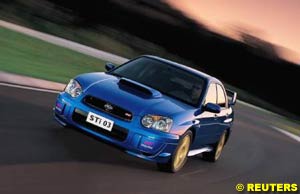 Its world rally giant stormed to victory after victory in the 1990s and enthusiasts clamoured for high performance versions of the Impreza. Yet all we got was the Impreza Turbo. With 211bhp it was not even a pale shadow of the WRX versions marketed in Japan - let alone the amazingly tuned 280bhp STi models which were effectively created by Subaru's rally team.
Its world rally giant stormed to victory after victory in the 1990s and enthusiasts clamoured for high performance versions of the Impreza. Yet all we got was the Impreza Turbo. With 211bhp it was not even a pale shadow of the WRX versions marketed in Japan - let alone the amazingly tuned 280bhp STi models which were effectively created by Subaru's rally team.
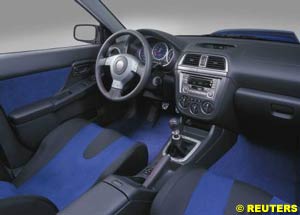 Ready for another astonishing surge of acceleration? Almost no other four-door saloon dishes up this much. Reaching 60mph takes just 5.2 seconds - easy to achieve because traction from the four-wheel drive system is so limpet-like. But every time you floor the accelerator while on the move, in-gear progress is just jaw-droppingly brutal. You can palpably feel the air whizzing round in the turbocharger as it feeds all 265 horses painlessly through the four-wheel drive.
Ready for another astonishing surge of acceleration? Almost no other four-door saloon dishes up this much. Reaching 60mph takes just 5.2 seconds - easy to achieve because traction from the four-wheel drive system is so limpet-like. But every time you floor the accelerator while on the move, in-gear progress is just jaw-droppingly brutal. You can palpably feel the air whizzing round in the turbocharger as it feeds all 265 horses painlessly through the four-wheel drive.
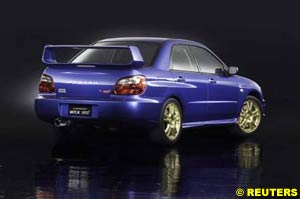 Subaru still hasn't got the hang of interiors. While rivals like the Alfa Romeo 156 GTA and Audi S4 ooze class and sophistication, the Impreza looks like a museum of tacky 1980s plastics. That's balanced by fantastic figure-hugging seats that hold you in place in those extreme manoeuvres that just keep on happening.
Subaru still hasn't got the hang of interiors. While rivals like the Alfa Romeo 156 GTA and Audi S4 ooze class and sophistication, the Impreza looks like a museum of tacky 1980s plastics. That's balanced by fantastic figure-hugging seats that hold you in place in those extreme manoeuvres that just keep on happening.
![]() The Price of Credibility, Quality and Kudos
The Price of Credibility, Quality and Kudos
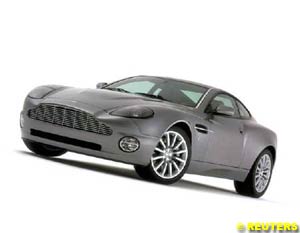 It has an aluminium body, built on an aluminium and carbon-fibre chassis; is capable of reaching 190mph, thanks to a howling six-litre V12 engine; incorporates the latest fly-by-wire electronic paddle-shift gearbox; and comes with a sumptuous leather and alcantara suede interior. Needless to say, its price is equally asphyxiating, at a fearsome £158,000, but of course it also comes with that Aston brand heritage, which is quite possibly priceless.
It has an aluminium body, built on an aluminium and carbon-fibre chassis; is capable of reaching 190mph, thanks to a howling six-litre V12 engine; incorporates the latest fly-by-wire electronic paddle-shift gearbox; and comes with a sumptuous leather and alcantara suede interior. Needless to say, its price is equally asphyxiating, at a fearsome £158,000, but of course it also comes with that Aston brand heritage, which is quite possibly priceless.
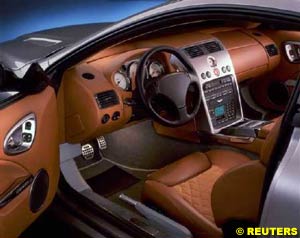 So why do they do it? In a word: globalisation. And in my opinion: nothing less than the idle, cheapskate result of an unhealthy relationship between a designer and an accountant. Aston Martin is owned by Ford, you see, and to save a few quid, the big blue oval's bean-counters probably allowed the Vanquish design team to get away with a few expensive headline features (the costly aluminium stuff) on the proviso that they also saved some money on one or two bucolic fixtures and fittings (the off-the-shelf Ford guff).
So why do they do it? In a word: globalisation. And in my opinion: nothing less than the idle, cheapskate result of an unhealthy relationship between a designer and an accountant. Aston Martin is owned by Ford, you see, and to save a few quid, the big blue oval's bean-counters probably allowed the Vanquish design team to get away with a few expensive headline features (the costly aluminium stuff) on the proviso that they also saved some money on one or two bucolic fixtures and fittings (the off-the-shelf Ford guff).
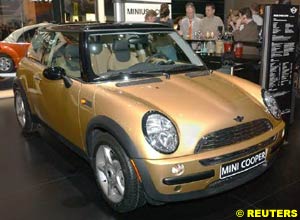 In fact, mention of Mercedes-Benz leads us neatly to the world's third biggest car company, Daimler-Chrysler, created through the merger of Daimler-Benz (makers of Mercedes, Maybach and Smart Cars) and the Chrysler Corporation (owners of the Dodge, Eagle, Jeep and Plymouth brands). Oh, and did I mention that Mercedes-Benz also has a (circa) 35% share in Mitsubishi, Japan's fourth largest manufacturer, which doesnıt appear to own any other car companies at all?
In fact, mention of Mercedes-Benz leads us neatly to the world's third biggest car company, Daimler-Chrysler, created through the merger of Daimler-Benz (makers of Mercedes, Maybach and Smart Cars) and the Chrysler Corporation (owners of the Dodge, Eagle, Jeep and Plymouth brands). Oh, and did I mention that Mercedes-Benz also has a (circa) 35% share in Mitsubishi, Japan's fourth largest manufacturer, which doesnıt appear to own any other car companies at all?
© 1995-2005 Kaizar.Com, Inc. . This service is provided under the Atlas F1 terms and conditions.
|
Volume 9, Issue 21
Atlas F1 Exclusive
The Forgotten Man: Interview with Trulli
Ann Bradshaw: View from the Paddock
Atlas F1 Special
A Tale of Two Chassis
Austrian GP Review
2003 Austrian GP Review
What It's All About
Completing the Set
Of Winning and Whining
Stats Center
Qualifying Differentials
SuperStats
Charts Center
Columns
Season Strokes
On the Road
Elsewhere in Racing
The Weekly Grapevine
> Homepage |